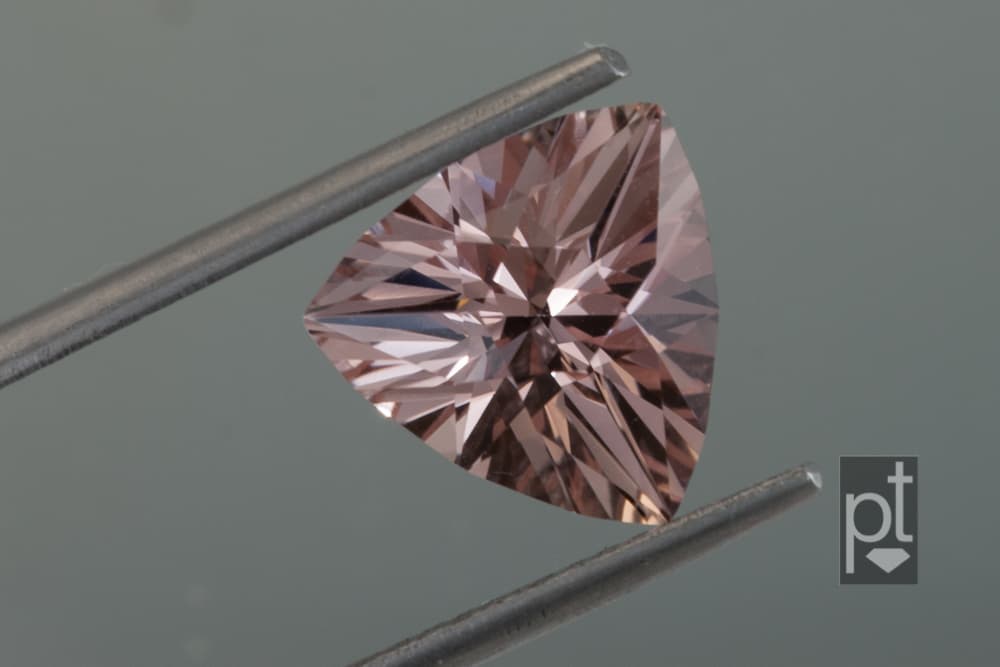Morganite Value, Price, and Jewelry Information
A member of the beryl family, morganite shows a range of pink colors due to traces of manganese. Recently, this gemstone has seen an increase in popularity and value. Like most beryls, morganite makes an excellent jewelry stone.
2 Minute Read
A member of the beryl family, morganite shows a range of pink colors due to traces of manganese. Recently, this gemstone has seen an increase in popularity and value. Like most beryls, morganite makes an excellent jewelry stone.
Start an IGS Membership today
for full access to our price guide (updated monthly).Morganite Value
Medium light to medium pink, clean stones with custom cuts are the most valuable. Very light and included stones are on the lower end of the value spectrum. As morganite frequently occurs in larger crystals, there is no exponential increase in price with size. Paradoxically, smaller morganites, if they show good color, can be more valuable than larger ones. In order to show good color, large stones must be so large that they’re impractical for use as jewelry. As is the case with unheated greenish blue aquamarine, a small but growing segment of collectors prefer the unheated peachy color of morganite and are willing to pay a premium to get an unenhanced, natural piece.
Comments
After morganite's discovery in Madagascar in 1910, Tiffany & Co introduced this gem to the American market. They named it in honor of the financier J. P. Morgan, who was himself reputed to be an avid gem collector.
Very often, you'll encounter near colorless beryl specimens offered as morganites. These stones should be labeled more properly as goshenite (colorless beryl).
Enhancements
Although violet and peach are possible morganite colors, the most common and preferred color is pink. Heat and light will remove the yellow component from peach beryl, so it's often heated to get "pinker" stones.
Synthetics
You can find hydrothermally grown synthetic morganites for sale as jewelry stones. If you're not sure whether your gem is natural or lab-grown, send it to a gemological lab for analysis.
Sources
Minas Gerais, Brazil produces fine crystals and gem material. Other locations producing gem-quality material include:
- United States: San Diego County, California (in several localities - fine crystals and gem material); Maine; Thomas Range, Utah.
- Madagascar: in pegmatites and as alluvial material.
- Afghanistan; Mozambique; Myanmar; Namibia; Pakistan.
Stone Sizes
Morganites don't usually occur in sizes as large as other beryls. Crystals have been found up to 6" in diameter.
In 1989, Ronald and Dennis Holden discovered a morganite measuring 30 cm wide at the Bennett Quarry in Maine. As rough, the "Rose of Maine" weighed 115,000 cts, approximately 50 lbs, the largest ever found in North America. This specimen yielded several cut gems, including a 184-ct faceted piece now residing at the Maine State Museum.
- Smithsonian Institution (Washington, DC): 287 (pink, Brazil) and 235 (pink, Brazil); 178 (pink, California); 113 (peach, California); 56 (pale pink, Madagascar); 330 (dark orange, Brazil).
- Natural Hist. Museum, Paris: 250 (pink, Madagascar).
- Royal Ontario Museum (Toronto, Ontario, Canada): 118.6 (pink, cat's eye).
- British Museum (Natural History) (London England): 598.7 (rich pink, square-cushion brilliant, Madagascar); rose-red crystal from California weighing 9 pounds.
- American Museum of Natural History (New York): 58.8 (heart-shaped, Madagascar).
- Private Collection: three very large cut gems with carved tables, total weight ~ 1,500 carats, tables carved in religious motifs.
Trade Names
Morganite is sometimes referred to as "pink beryl."
Although emerald belongs to the same beryl family, the term "pink emerald" shouldn't be used for morganite. Unfortunately, some vendors reference more well-known gem names to drum up interest (and prices) for another gem. Beryls in particular receive these names from dishonest sellers because of the popularity of emerald and aquamarine. Although morganites are very rare, their prices don't approach those for emerald. To insinuate these are a variety of one of the most expensive gems on the market is misleading.
For another example of this deceptive practice, read our caveat on goshenites sold as "white aquamarines."
Care
Morganites have the hardness and durability to make excellent jewelry stones for daily wear.
If free of inclusions or fractures, they may be cleaned using mechanical systems. Have a gemologist examine your gems first to identify any potential weaknesses. However, a soft brush, mild detergent, and warm water will always work safely.
Consult our Gemstone Jewelry Cleaning Guide for more recommendations.
Joel E. Arem, Ph.D., FGA
Dr. Joel E. Arem has more than 60 years of experience in the world of gems and minerals. After obtaining his Ph.D. in Mineralogy from Harvard University, he has published numerous books that are still among the most widely used references and guidebooks on crystals, gems and minerals in the world.
Co-founder and President of numerous organizations, Dr. Arem has enjoyed a lifelong career in mineralogy and gemology. He has been a Smithsonian scientist and Curator, a consultant to many well-known companies and institutions, and a prolific author and speaker. Although his main activities have been as a gem cutter and dealer, his focus has always been education.
Donald Clark, CSM IMG
Barbara Smigel, PhD. GG
Barbara Smigel is a GIA certified gemologist, facetor, jewelry designer, gem dealer, gemology instructor and creator of the well-regarded educational websites acstones.com and bwsmigel.info.
International Gem Society
Related Articles
Morganite Buying Guide
Buying Gemstones in Afghanistan: A Beginner’s Guide
Are White Aquamarines Genuine Aquamarines?
Pearl Value, Price, and Jewelry Information
Never Stop Learning
When you join the IGS community, you get trusted diamond & gemstone information when you need it.
Get Gemology Insights
Get started with the International Gem Society’s free guide to gemstone identification. Join our weekly newsletter & get a free copy of the Gem ID Checklist!
